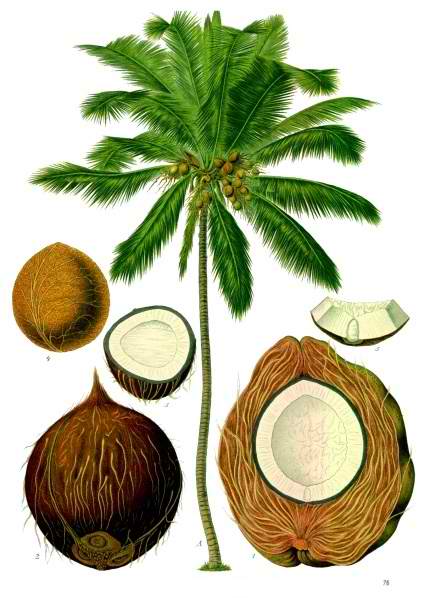
Plant
Cocos nucifera is a large palm, growing up to 30 m (98 ft) tall, with pinnate leaves 4–6 m (13–20 ft) long, and pinnae 60–90 cm long; old leaves break away cleanly, leaving the trunk smooth. Coconuts are generally classified into two general types: tall and dwarf. On very fertile land, a tall coconut palm tree can yield up to 75 fruits per year, but more often yields less than 30, mainly due to poor cultural practices. In recent years, improvements in cultivation practices and breeding have produced coconut trees that can yield more.
Fruit
Botanically, the coconut fruit is a drupe, not a true nut. Like other fruits, it has three layers: the exocarp mesocarp, and endcarp. The exocarp and mesocarp make up the "husk" of the coconut. Coconuts sold in the shops of nontropical countries often have had the exocarp (outermost layer) removed. The mesocarp is composed of a fiber, called coir, which has many traditional and commercial uses. The shell has three germination pores (stoma) or "eyes" that are clearly visible on its outside surface once the husk is removed.
A full-sized coconut weighs about 1.44 kg (3.2 lb). It takes around 6,000 full-grown coconuts to produce a tonne of copra.
Roots
Unlike some other plants, the palm tree has neither a top root nor root hairs, but has a fibrous root systems.
The coconut palm root system consists of an abundance of thin roots that grow outward from the plant near the surface. Only a few of the roots penetrate deep into the soil for stability. The type of root system is known as fibrous or adventitious, and is a characteristic of grass species. Other types of large trees produce a single downward-growing tap root with a number of feeder roots growing from it.
Coconut palms continue to produce roots from the base of the stem throughout its life. The number of roots produced depends on the age of the tree and the environment, with more than 3,600 roots possible on a tree that's 60 to 70 years old.
Roots are usually less about 3 inches in diameter and uniformly thick from the tree trunk to the root tip.
Inflorescence
The palm produces both the female and male flowers on the same influrenscene; thus, the palm is monoecious. Other sources use the term polygamomonoecious . The female flower is much larger than the male flower. Flowering occurs continuously. Coconut palms are believed to be largely cross pollinated, although some dwarf varieties are self-pollinating.

